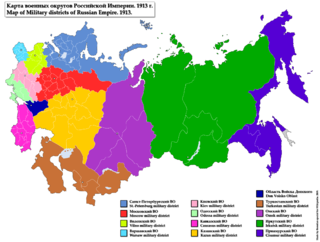 W
WThe Azerbaijani Legion was one of the foreign units of the Wehrmacht. It was formed in December 1941 on the Eastern Front as the Kaukasische-Mohammedanische Legion and was re-designated 1942 into two separate legions, the North Caucasian legion and the Azerbaijani legion. It was made up mainly of former Azerbaijani POW volunteers but also volunteers from other peoples in the area. It was part of the Ostlegionen. It was used to form the 162nd (Turkistan) Infanterie-Division of the Wehrmacht in 1943. Later, some of these Azerbaijanis joined the Azeri Waffen SS Volunteer Formations.
 W
WThe Baku Governorate was one of the guberniyas of the Caucasus Viceroyalty of the Russian Empire, with its centre in Baku. Area (1897): 34,4000 sq. versts, population (1897): 789,659. The only foreign border of the governorate was Persia to the south. Within the empire, it bordered the Elisabethpol Governorate and the Dagestan Oblast.
 W
WThe Caucasus Military District was a military formation of the Imperial Russian Army. It was created in 1865 as the successor to the Caucasus Army, and was dissolved in 1917.
 W
WThe Caucasus Viceroyalty was Imperial Russia's administrative and political authority in the Caucasus region exercised through the offices of glavnoupravlyayushchiy and namestnik (наместник). These two terms are commonly, but imprecisely, translated into English as viceroy, which is frequently used interchangeably with governor general. More accurately, glavnoupravljajuščij is referred to as High Commissioner of the Caucasus, and namestnik as Viceroy.
 W
WThe Declaration of Independence of Azerbaijan is the declaration of independence of the Azerbaijan Democratic Republic from the Russian Empire. Azerbaijan was proclaimed independent in Tiflis on 28 May 1918.
 W
WElisabethpol Governorate or Elizavetpol Governorate or Elizavetapol Governorate was one of the guberniyas of the Caucasus Viceroyalty of the Russian Empire, with its centre in Elisabethpol. Its area was 44,136 sq. kilometres, and it had 878,415 inhabitants by 1897.
 W
WThe national flag of the Republic of Azerbaijan is a horizontal tricolour featuring three equally sized fesses of bright blue, red, and green, with a white crescent and an eight-pointed star in the center. The tricolour replaced an earlier design used by the Azerbaijan SSR. The bright blue symbolizes Azerbaijan's Turkic heritage, the red stands for progress, and the green represents Islam, the religion of majority of Azerbaijanis. The official colors and size were adopted on 5 February 1991. This flag was used from 9 November 1918 to 1920, when Azerbaijan was independent, and it was revived with slight variations on 5 February 1991. The nickname for the flag is The Tricolour Flag.
 W
WKazakh sultanate or Gazakh sultanate was established at the end of the XV century. During the Safavid Empire, it was part of the Karabakh principality. In 1605, by the decree of Abbas the Great, Shamsaddin sultan of Kazakh was given the rank of Khan.
 W
WThe Mughan Soviet Republic was a short-lived pro-Bolshevik state that existed in present-day southeastern Azerbaijan from March to June 1919. It was founded in opposition to the Musavatist Azerbaijani Government in Baku.
 W
WRepublic Day honours the date on which the Azerbaijan Democratic Republic (ADR) was founded as the first secular democratic state in the Muslim East: 28 May 1918. Since 1990, Republic Day is celebrated as a national holiday in Azerbaijan.
 W
WThe Republic of Aras was a short-lived and unrecognized state in the South Caucasus, roughly corresponding with the territory that is now the Nakhchivan Autonomous Republic of Azerbaijan. Named after the Aras River that formed its southern border, the republic was declared in December 1918 by Jafargulu Khan Nakhchivanski with support from the Azerbaijan Democratic Republic's ruling party, the Musavat Party, and the government of the Ottoman Empire.
 W
WShamshadil, Shamshaddil, or The Sultanate of Shamshaddil was a sultanate established in 1747. Its area was 4,200 versts, and the population mainly consisted of Zulgadar clan, taking roots from the Qizilbash Turkic tribes. The sultanate was located near Lake Sevan and covered the territories of the modern day Tavush Province in Armenia and some parts of Tovuz District in Azerbaijan, with the center in the village of Oksuzlu, in the territory of Tovuz.
 W
WThe Baku Governorate was one of the guberniyas of the Caucasus Viceroyalty of the Russian Empire, with its centre in Baku. Area (1897): 34,4000 sq. versts, population (1897): 789,659. The only foreign border of the governorate was Persia to the south. Within the empire, it bordered the Elisabethpol Governorate and the Dagestan Oblast.
 W
WThe Special Transcaucasian Committee was established on March 9, 1917, with Member of the State Duma V. A. Kharlamov as Chairman, to replace the Imperial Viceroy Grand Duke Nikolai Nikolaevich and with special instruction to establish civil administrations in areas occupied in the course of the war on the Caucasian front by the Russian Provisional Government in the Transcaucasia as the highest organ of civil administrative body. Commissars were appointed for the Terek Oblast and the Kuban Oblast, and these as well as the Committee were to carry on relations with central government institutions through a Commissar for Caucasian Affairs in Petrograd attached to the Provisional Government.
 W
WThe Transcaucasian Democratic Federative Republic also known as the Transcaucasian Federation, was a short-lived South Caucasian state extending across what are now the modern-day countries of Armenia, Azerbaijan and Georgia, plus parts of eastern Turkey as well as Russian border areas. The state only lasted for a month before Georgia declared independence, followed shortly by Azerbaijan and Armenia.
 W
WThe Transcaucasian Socialist Federative Soviet Republic, also known as the Transcaucasian Soviet Federative Socialist Republic, was a republic of the Soviet Union that existed from 1922 to 1936.